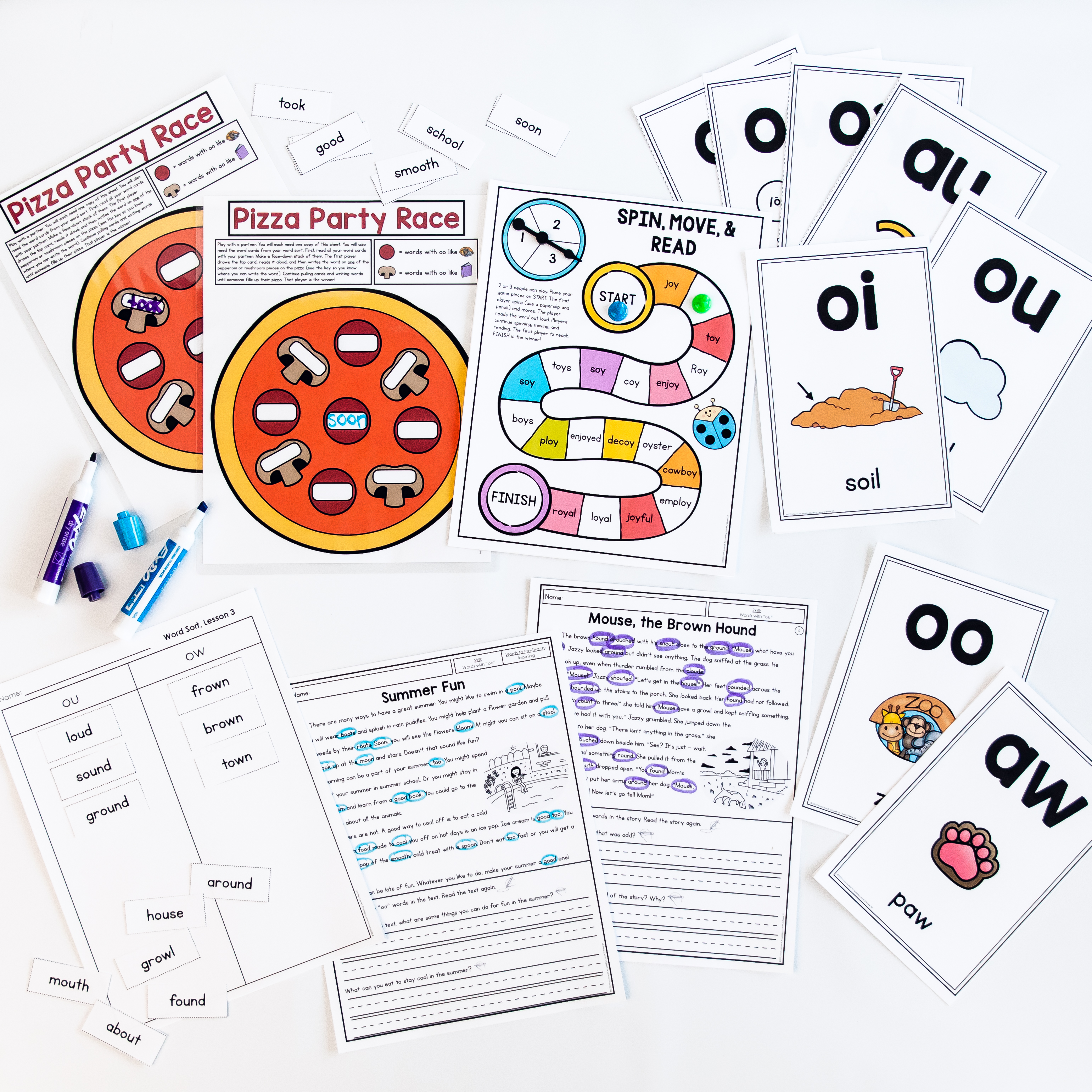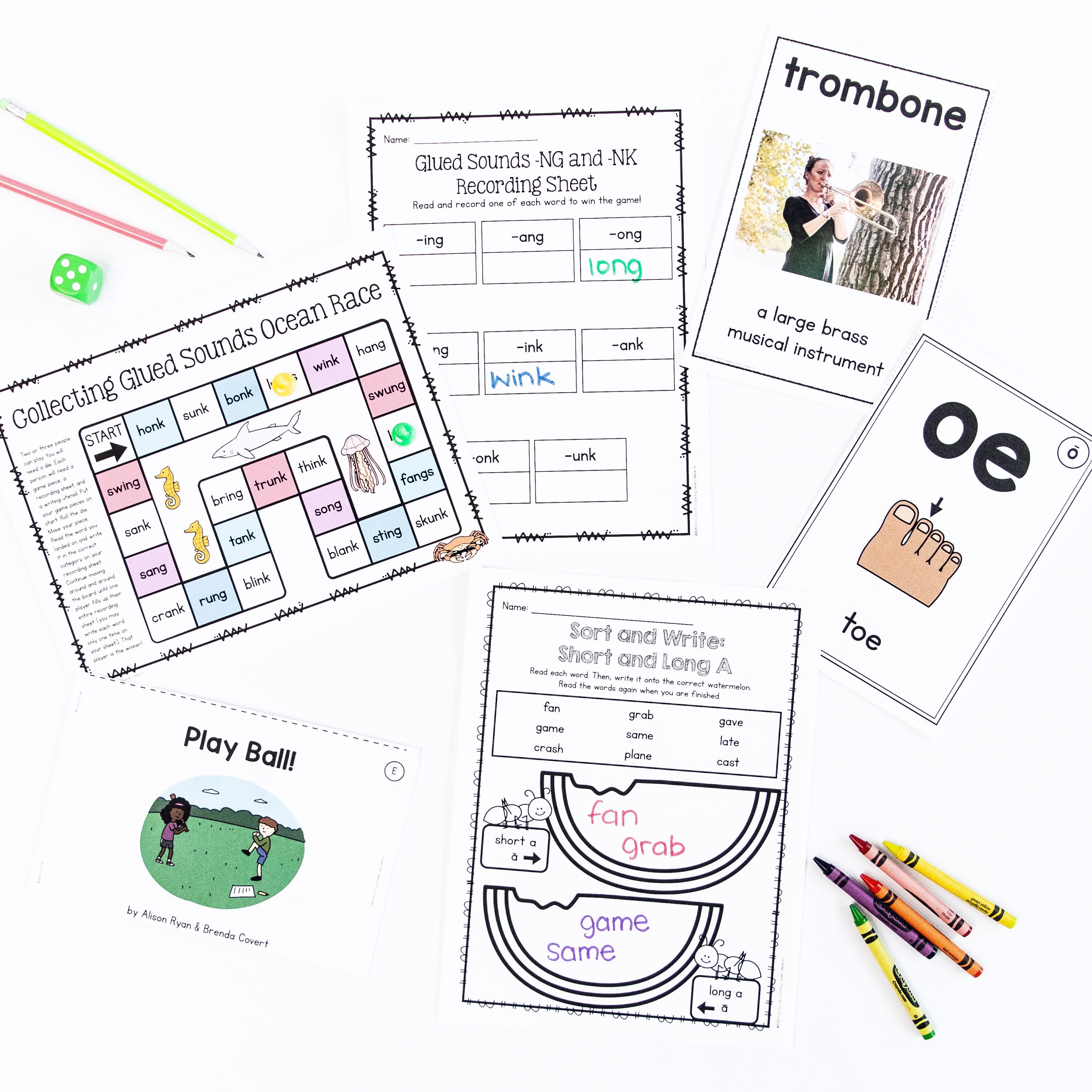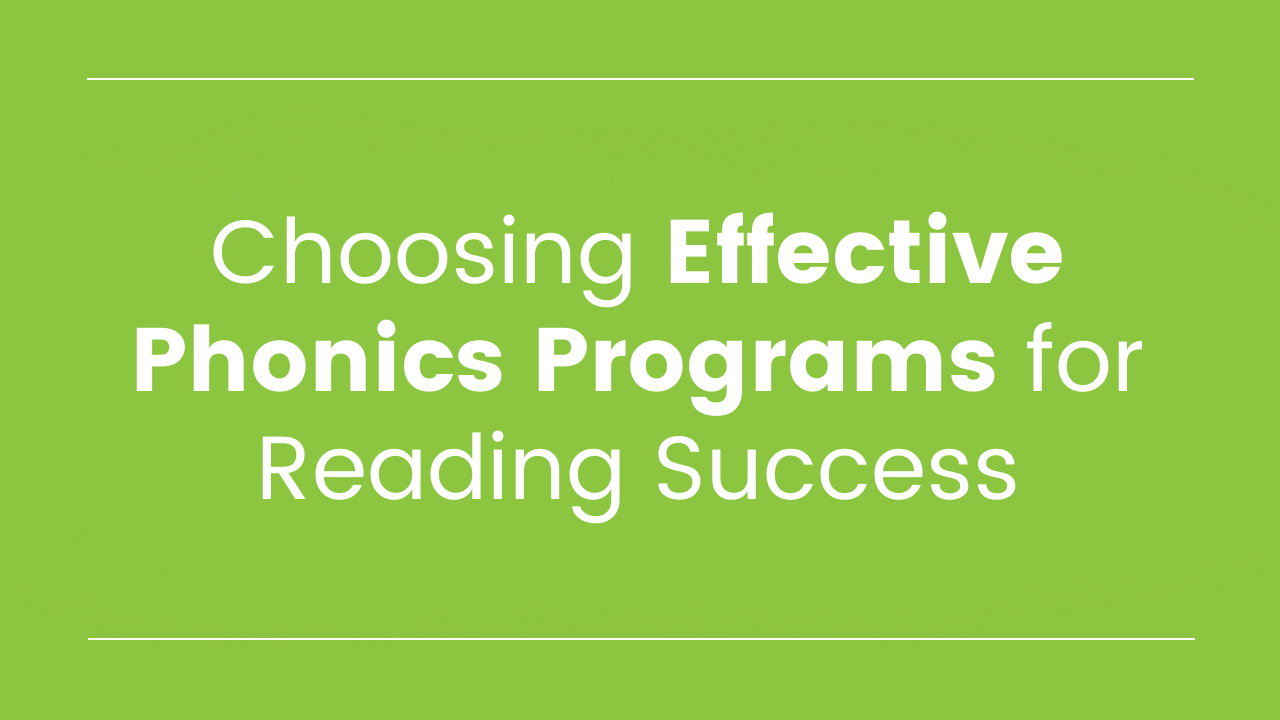We can think of phonics instruction as the "foundation" of the "reading house." When students have a strong foundation in phonics concepts, they can build reading fluency. When students' reading fluency improves, their comprehension usually does, too. On the other hand, having a shaky foundation in phonics results in student difficulties in reading. In fact, lots of older students struggle with reading because they have underlying deficiencies in phonics. Because they can't decode many of the words in a text, their fluency is poor, and this impacts their reading comprehension.
School leaders who understand the importance of a strong phonics foundation want to choose the right phonics programs for their students and teachers. A phonics program makes it easy for teachers to follow best practices and deliver effective instruction. In this article, we'll cover what a phonics program is, characteristics that schools should look for as they are reviewing programs, and other important considerations in choosing a phonics program.
First, let's define the concept of a phonics program. Phonics instruction involves teaching the relationships between letters and sounds. A phonics program provides materials and resources for teachers to instruct students in these concepts. Most phonics programs also include materials for students to use as they practice skills, like decodable texts, practice sheets, word sorts, and so on.
A phonics program might also include instruction and resources on these additional literacy skills:
When choosing a great phonics program, schools will want to look for a program that embodies the following characteristics:
1. Systematic phonics instruction
Systematic phonics instruction involves teaching a list of phonics skills (like alphabet letters, digraphs, consonant blends, long vowels, diphthongs, etc.) in developmental order. An effective phonics program will include a scope and sequence that shows teachers what to teach and when. Teachers do not randomly select phonics skills to teach, nor do they choose phonics skills based upon the words that appear in the stories they are reading to or with children. Rather, they stick to the scope and sequence. When students are struggling with a skill, they wait until students have mastered it before moving on. Systematic phonics instruction has been shown to be effective in research and aligns with the Science of Reading. From Sounds to Spelling (R) uses a systematic approach to teaching phonics.
2. Explicit phonics instruction
Explicit phonics instruction involves clearly teaching students the relationships between letters and their corresponding sounds. This extends far beyond the letter sounds in the alphabet, and includes concepts like digraphs, vowel teams, diphthongs, and more. Effective phonics programs provide instructions to the teacher on what to say and do to introduce each new skill. Students then practice a phonics skill through activities like spelling words, reading words, and reading decodable texts. Teachers are directed to observe student performance and provide corrective feedback as needed. Assessments are included so that teachers can adjust their instruction accordingly. Research has shown that explicit instruction is the most effective instructional approach for teaching phonics (and for all literacy skills, per the Science of Reading). From Sounds to Spelling (R) uses an explicit approach to teaching phonics.

3. A research and evidence base
Effective phonics programs use instructional methods that research (studies and meta-analyses about teaching phonics) has shown to be effective. Effective programs also have results that prove that their specific program leads to improved reading outcomes in their students (better results in students' phonics knowledge, reading, and spelling abilities). Click here to receive a free trial of From Sounds to Spelling (R), and make sure to check out the informational packet that details the research and studies behind our program.
4. Resources and guidance for differentiation
Although many top programs fail to provide sufficient resources for differentiation, effective phonics programs like From Sounds to Spelling (R) take into account the fact that students have a variety of academic needs. Research has shown that phonics instruction is most effective when it is differentiated. All children learn phonics skills in more or less the same order, but they each acquire phonics knowledge at their own pace. Therefore, quality phonics curriculum include options that teachers can leverage to effectively meet students' unique needs (i.e. small group instruction options). Practice activities at a variety of levels should also be included. Teachers are busy and need to have different ways and different tools to help ALL their students succeed. Teachers shouldn't be left to guess at how to differentiate for their students.
5. Training and support for teachers
Professional development is key for teachers to truly understand how to use any program. Live professional development sessions are very helpful, but it's also important to think about teachers who miss a session, or join the school after professional development has ended. Moreover, what should teachers do when they've already attended a professional development session but need to review concepts or get more support in implementing the program? Ideally, phonics programs include embedded professional training, like From Sounds to Spelling (R) does. Teachers' login portals include multiple videos to help them understand how to teach each unit. There are also helpful videos on specific topics like differentiation or teaching high frequency words. Teachers can access the videos whenever they need to.
Here are some other important things school leaders should consider when selecting a phonics program:
1. How well does the program address the needs of English language learners? Are visual aids present, as well as teaching tips for teachers?
From Sounds to Spelling (R) includes many visual aids, including a phonics poster with a picture for each phonics pattern that is taught. The program also incorporates weekly vocabulary instruction, which is essential for English language learners (and all students). Vocabulary posters with real photographs help students learn these new words. The program also includes suggestions for teachers about how to adapt the program to meet the specific needs of English language learners.

2. How well does the program support teachers who are new to teaching phonics? Are the lesson plans easy for anyone to pick up and teach? Are the materials easily accessible?
Since From Sounds to Spelling (R) includes embedded professional development, teachers who need to grow their professional knowledge around phonics instruction can watch the training videos at any time. The lesson plans are clearly written, so even a brand-new or substitute / temporary teacher can pick up the program and quickly begin teaching it for the first time. Additionally, the program materials are clearly organized inside a login portal. Teachers can print or reprint materials at any time, without having to deal with the hassle of re-ordering resources every semester or school year. Our licenses are transferrable, meaning that if a teacher leaves your school, you can transfer their license to a new teacher at no additional cost!
3. Does the program allow for flexibility? Can the scope and sequence be adjusted based upon student progress? Are there accommodations made for struggling readers? What about more advanced students?
A key component of From Sounds to Spelling (R) is flexibility! We know that students do not acquire phonics knowledge at the same pace. Certain students or the entire class may need additional support on a skill, even if the lessons for that skill have already been taught. Therefore, although From Sounds to Spelling (R) is a sequential phonics program, the lessons guide teachers in using student assessment data to adjust their pace and instruction. Informal assessments are included at the end of each week, as well as "pre" and "post" assessments for the year, plus unit assessments. Sometimes young learners need more time to master a concept, so extra materials are provided in each weekly PDF.
Additionally, From Sounds to Spelling (R) was created to accommodate a range of students, including struggling readers. It includes decodable texts at different difficulty levels, so teachers can teach multiple groups of students the same skill, while providing materials at their level. When applicable, the program also includes 2-3 versions of each weekly word sort, so teachers can select the right option for their students. Differentiation suggestions are included throughout the program, both to support struggling learners and to challenge more advanced learners. Since a multisensory approach is recommended for students with special needs, multisensory activities are embedded throughout the program. This way, classroom teachers can meet the needs of all their students, without having to spend hours searching for additional activities.
4. How does the program support effective classroom management? Are consistent routines in place, so students know what to expect? Are the activities realistic for young children?
From Sounds to Spelling (R) helps teachers teach and stick to specific, consistent routines. For example, students might read decodable texts on Tuesdays, Thursdays, and Fridays, and complete a word sort each Wednesday. At the beginning of each of the grade levels in our program (Kindergarten, 1st grade, and 2nd grade), the lesson plans help teachers gradually roll out these routines, so that students learn expectations in a systematic way. Variety is provided through the materials, but the consistency in routines helps students know what to expect. When students know what to expect, teachers see fewer behavioral problems. Additionally, because students learn the consistent routines, it becomes easy and fast for them to take out materials, move into groups, etc. This helps maximize instructional time. Last but not least, our program was written by a reading specialist and former classroom teacher, so the activities truly work with children at these ages.
Next, let's discuss the scope of a phonics or reading program. Some early reading programs are all-encompassing. You might know these as "basal reading programs" or "series." They provide stories for working on comprehension, vocabulary instruction, phonics instruction, writing instruction, grammar lessons, and so on. Essentially, they are "all in one" solutions, and many districts believe they are a great way to "take care of" all of their elementary grades' reading instruction with a single purchase.
However, there are a few disadvantages to choosing an "all in one" solution like this:
1. The quality of instructional materials in that single program may vary from subject to subject. A common complaint of teachers in elementary schools is that their reading program does not sufficiently or effectively address phonics or writing. By trying to "do everything," publishers fail to provide quality resources in every subject area. Or, even if the materials are high-quality, different teachers and different schools simply have unique preferences and needs that would be best suited by purchasing a few different components to support early reading instruction.
2. These programs often include a huge number of resources that can be overwhelming to teachers. An early reading program might, for example, come with 10 different teacher manuals, student workbooks, sets of decodable texts, and other resources. Although you'd think that having lots of materials would generally be a good thing, this is only true if teachers actually use the materials. Because these programs include so much (sometimes too much), it is common for teachers to not end up using many of the resources. (On the flip side, we've gotten lots of feedback from our From Sounds to Spelling (R) teachers who remark upon how "teacher friendly" our program is. Each weekly PDF provides everything they need to teach the materials, so they aren't flipping through tons of different manuals or booklets.)
3. These all-in-one reading programs can be costly. These large programs cost districts and schools tens of thousands of dollars. They end up spending even more on professional development, as well as to replenish consumable materials like workbooks each year. On top of all of these costs, teachers end up seeking out additional supplementary resources, due to the challenges described in #1 and #2 in this list. An all-in-one reading program can be a risky investment, and it's not an inexpensive one, either. (From Sounds to Spelling (R), on the other hand, is very cost effective - you can see prices here.)
For these three reasons, it can make sense to choose an instructional program that focuses exclusively on phonics. From Sounds to Spelling (R) is successful because we focused on what we do best - helping teachers deliver effective phonics instruction! The complete program also fully addresses phonological awareness and phonemic awareness, as well as high frequency words. Teachers have everything they need to teach students how to decode and spell words, including multisyllable words (when applicable to students' developmental levels). Students also have opportunities to learn vocabulary and practice comprehension via the included decodable readers. There's even an optional handwriting component of the program, which can easily be eliminated if your school already has a handwriting program in place.
Effective phonics programs have a huge impact on student reading achievement. As you probably already know, reading unlocks countless doors for students, in their academic lives and beyond. This is what makes choosing the right phonics program so important.
However, choosing the right phonics program doesn't have to be a huge challenge, expense, or stressor! From Sounds to Spelling (R) addresses all the considerations discussed in this article (and more!). To access a free trial of From Sounds to Spelling (R), click here.







